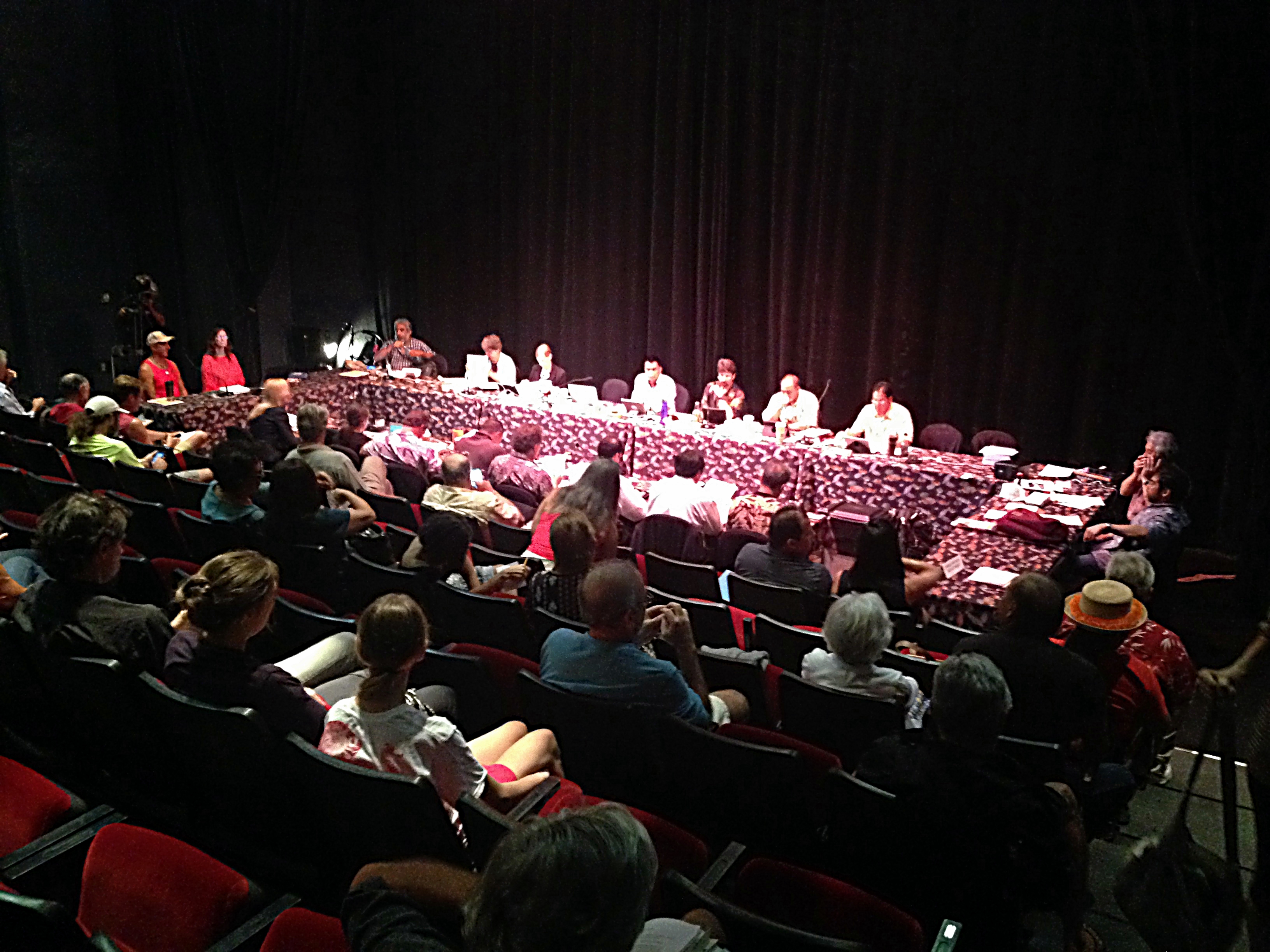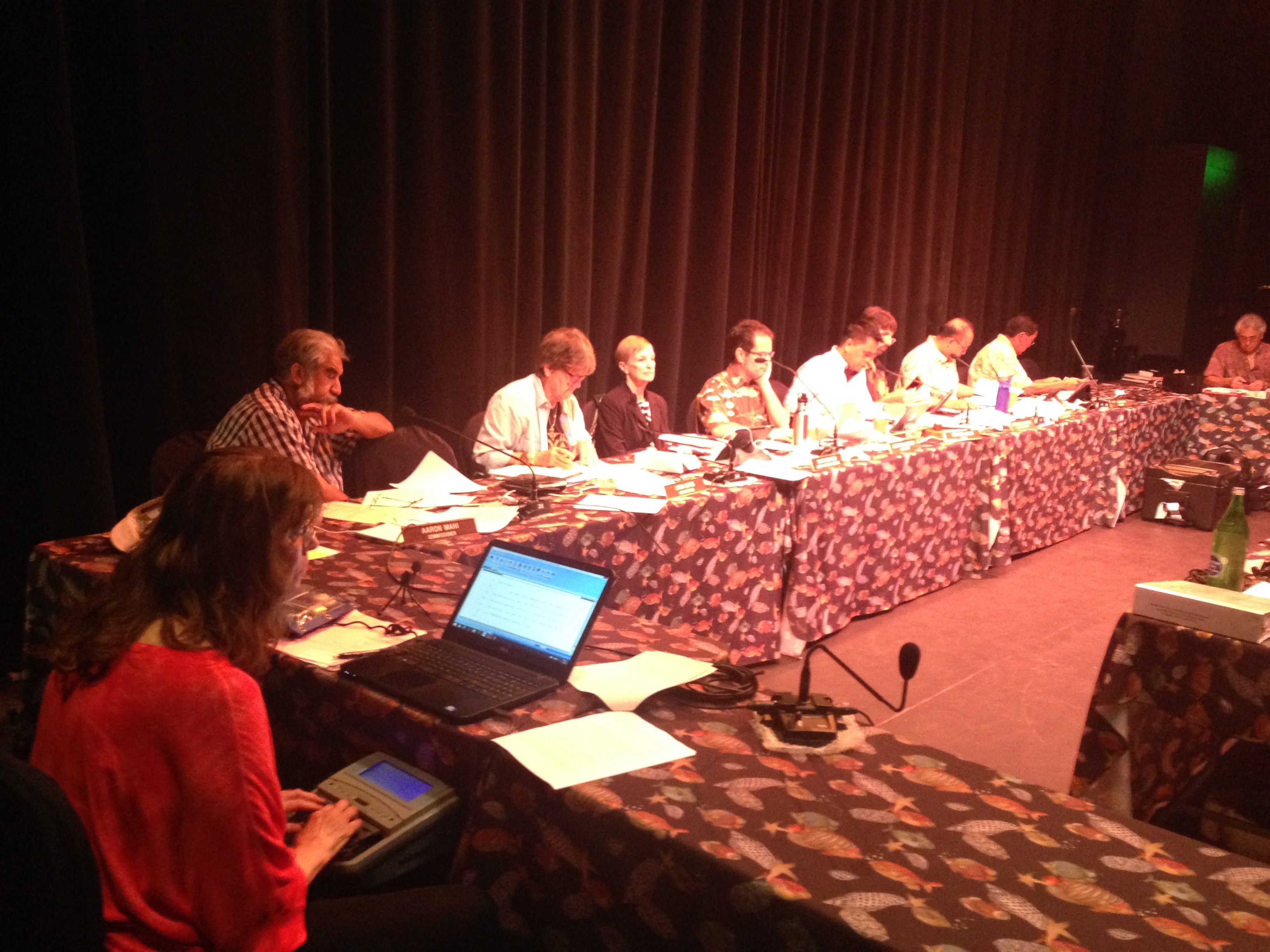UPDATE: Testimony on Olowalu Town Project Final EIS Continues

Lisa Marquis (from left), Peter deAquino, Davin Balagso and Kiana Carroll, all from Lahaina, came prepared both with signs and testimony against the Olowala Final Environmental Impact Statement. Debra Lordan photo.
UPDATE: Thursday, Nov. 19, 3 p.m.
The state Land Use Commission voted this morning to approve the 15-day extension requested by the applicants, Olowalu Town LLC and Olowalu Ekolu LLC.
A number of LUC commissioners asked the applicants to be prepared to answer questions based upon public testimony when the matter is next heard.
The LUC will meet again on Maui sometime before Dec. 10 to complete its hearing of the matter.
Public testimony continued until approximately 6 p.m. yesterday, with 82 residents weighing in on the Final Environmental Impact Statement for the Olowalu project— 13 were in support of the project/FEIS (including two from the Grass Roots Institute of Hawai‘i from O’ahu) and 69 testified against the project/FEIS.
There was no additional public testimony allowed today, but it will be allowed during the December meeting.
ORIGINAL POST: Wednesday, Nov. 16, 3 p.m.
As of noon on Wednesday, Nov. 18, the state Land Use Committee heard from 31 of the 84 Maui residents who signed up to testify at the Maui Arts & Cultural Center’s McCoy Studio Theater regarding acceptance of the Olowalu Town LLC and Olowalu Ekolu LLC’s Final Environmental Impact Statement, a 3,000-page document made available to the public 18 days ago.
The theater’s 250 seats were nearly all filled, with some attendees standing in the aisles.
Although an LUC commissioner reminded testifiers early on that this was not a forum for testifying for or against the project, but a venue in which to weigh in on the acceptability of the FEIS, most testifiers continued to give their input on the project itself, rather than the efficacy of the FEIS document.

The state Land Use Committee heard from Maui residents who signed up to testify at the Maui Arts & Cultural Center’s McCoy Studio Theater regarding acceptance of the Olowalu Town LLC and Olowalu Ekolu LLC’s Final Environmental Impact Statement. Debra Lordan photo.
Maui’s residents were passionate, some testifying through tears as they described Olowalu as a place of refuge, of ‘ohana, of childhood memories. Other testimony was based on scientific research, with several credible studies being called into play.
The first dozen testifiers were split down the middle—half for and half against the project/FEIS. But by the afternoon break, a majority of the 31 residents who testified expressed serious reservations about the project, with seven for and 24 against the project/FEIS.
Most of the testifiers who assessed the FEIS document itself called it flawed, defective, vague, inadequate, insufficient, inaccurate and incomplete.
A marine scientist commented on the FEIS, saying, “As weighty as it is, it is filled with … 4,000 to 5,000 people living adjacent to a reef is going to have a disastrous effect. This was and still is a place of refuge for thousands. This is our time to protect it.”
An engineer weighed in on the FEIS, saying, “It does not give me a warm, fuzzy feeling.” She talked about West Maui’s Mahana Ridge project, a 125-acre residential development in the infrastructure phase, as an example of “best management practices” gone wrong. Using BMP, she said, “was not enough.” Runoff containing sediment from construction work damaged and killed the nearby reef.
Others who opposed to the project claimed the development would limit public access to the coastline, impact ocean users and water sources, pose threats to nearshore marine environments and already endangered species, disrupt rainfall patterns, and threaten traditional and customary use of the coast. Opponents also saw the project as a source of overcrowded schools, additional traffic and as an impediment to evacuation routes.
Several testifiers brought up the fact that the area is in a tsunami zone, with one asking, “Who will be responsible for all those people?”
Another testifier noted that the project’s water treatment plant would be constructed within the tsunami inundation zone. “This is not an experiment,” he said.
A few of the Hawaiian testifiers said actual ownership of the land was in contention, one asking for proof that the land was in fact legally owned by the developers.
“Show me clear title to the land, then go ahead and develop the heck out of it,” said the testifier.
“The rights of the Native Hawaiian are dismissed. The rights of the people are pushed to the side,” said a Hawaiian testifier, adding, “What goes around comes around.”
“You guys are committing fraud,” said another.
“We know this place; you don’t,” said another. “We already know what the right decision is. We don’t want it.”
“Of course there will be impacts. This is not fair to either side, but I’m not willing to take chances with Olowalu,” said another testifier.
Those in favor of the project named affordable housing for their children and grandchildren as the main reason for accepting the FEIS.
According to the FEIS document, the Master Plan area consists of 23 agricultural parcels encompassing approximately 636 acres with approximately 1,500 dwelling units.
Kula resident Richard Mayer commented on the project’s potential for housing, saying that the original EIS included 1,000 affordable housing units; the FEIS now includes only 375.
As of 1 p.m., it was unclear as to how long the meeting would continue, with 53 more testifiers in the queue. At that time, there was no testimony on the agenda for a separate LUC meeting scheduled for 8:30 a.m. on Thursday, Nov. 19, 2015.
The FEIS for the Olowalu Town Master Plan seeks the reclassification of approximately 320 acres of land situated at Olowalu from the Agricultural District to the Rural and Urban Districts.
The FEIS says the project will help to address housing needs in West Maui, with a development that discourages outward urban sprawl. The Planning Department’s Long Range Division has estimated the housing need in West Maui to be “approximately 3,500 additional units by 2030, beyond those lands already entitled.”
Check back with Maui Now for updates on the ongoing testimony.
FEIS LINKS
FEIS-Proposed-Olowalu-Town-Master-Plan-Volume-1-of-4
FEIS-Proposed-Olowalu-Town-Master-Plan-Volume-2-of-4
FEIS-Proposed-Olowalu-Town-Master-Plan-Volume-3-of-4
FEIS-Proposed-Olowalu-Town-Master-Plan-Volume-4-of-4












